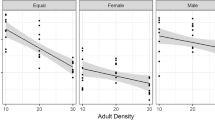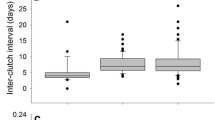Abstract
A reproductive tradeoff between current egg production and subsequent survival in a lady beetle, Epilachna niponica, a specialist herbivore on a thistle, Cirsium kagamontanum, was investigated at the two study sites, A and F. Survival of reproductive females decreased consistently from early May until mid-June, but apparently increased thereafter. In contrast, males showed a consistent decrease in survival throughout the reproductive season, without any sign of recovery. Dissection of ovaries of sampled females revealed that egg resorption increased late in the reproductive season, coincident with increased female survival. Reproductive females stopped oviposition immediately after a large flood in 1979 at site F. Two weeks after the habitat perturbation, females resumed oviposition in response to a flush of new leaves on damaged plants. Female survival sharply increased during the nonoviposition period, and declined when egg-laying resumed. Approximately 40% of long-lived reproductive females at site F survived up to the following reproductive season in the next year. Also, some of these long-lived females were observed ovipositing in the following reproductive season. The long-lived reproductive females which had previously invested in reproduction survived equally well as newly emerged females which had not reproduced in summer. These results suggest that there is a reproductive tradeoff between current egg production and subsequent survival. Egg resorption may be an adaptive ovipositional response to habitat perturbation such as flooding, which considerably reduces offspring fitness due to absolute shortage of food. Also, increased female survival accompanied by egg resorption enhances the likelihood of the future oviposition in the second reproductive season, thereby increasing a female's lifetime reproductive success.
Similar content being viewed by others
References
Bell G, Koufopanou V (1986) The cost of reproduction. In: Dawkins R Ridley M (eds) Oxford surveys in evolutionary biology. Oxford University Press, Oxford, pp 83–131
Bell WJ, Bohm MK (1975) Oosorption in insects. Biol Rev 50: 373–396
Boggs CL (1992) Resource allocation: exploring connections between foraging and life history. Funct Ecol 6: 508–518
Boggs CL, Ross CL (1993) The effect of adult food limitation on life history traits in Speyeria mormonia (Lepidoptera: Nymphalidae). Ecology 74: 433–441
Calow P (1979) The cost of reproduction—a physiological approach. Biol Rev 54: 23–40
Connell JH, Sousa WP (1983) On the evidence needed to judge ecological stability or persistence. Am Nat 121: 789–824
Craig TP, Itami JK, Price PW (1990) Intraspecific competition and facilitation by a shoot-galling sawfly. J Anim Ecol 59: 147–159
Dunlap-Pianka H, Boggs CL Gilbert LE (1977) Ovarian dynamics in heliconiine butterflies: programmed senescence versus eternal youth. Science 197: 487–490
Hassell MP, Lawton JH, May RM (1976) Patterns of dynamical behaviour in single-species populations. J Anim Ecol 45: 471–486
Jolly GM (1965) Explicit estimates from capture-recapture data with both death and immigration-stochastic model. Biometrika 52: 225–247
Kaitala A (1991) Phenotypic plasticity in reproductive behaviour of waterstriders: trade-offs between reproduction and longevity during food stress. Funct Ecol 5: 12–18
Kurihara M (1975) Anatomical and histological studies on the germinal vesicle in degenerating oocyte of starved females of the lady beetle, Epilachna vigintioctomaculata Motschulsky (Coleoptera, Coccinellidae). Kontyû 43: 91–105
Lomnicki A (1988) Population ecology of individuals. Princeton University Press, Princeton, New Jersey
Nakamura K, Ohgushi T (1979) Studies on the population dynamics of a thistle-feeding lady beetle, Henosepilachna pustulosa (Kono) in a cool temperate climax forest. I. The estimation of adult population parameters by the marking, release and recapture method. Res Popul Ecol 20: 297–314
Ohgushi T (1983) Population processes and life history strategy in an herbivorous lady beetle, Henosepilachna niponica (Lewis). PhD thesis, Kyoto University, Kyoto
Ohgushi T (1986) Population dynamics of an herbivorous lady beetle, Henosepilachna niponica, in a seasonal environment. J Anim Ecol 55: 861–879
Ohgushi T (1991) Lifetime fitness and evolution of reproductive pattern in the herbivorous lady beetle. Ecology 72: 2110–2122
Ohgushi T (1992) Resource limitation on insect herbivore populations. In: Hunter MD, Ohgushi T, Price PW (eds) Effects of resource distribution on animal-plant interactions. Academic Press, San Diego, pp 199–241
Ohgushi T (1995) Adaptive behavior produces stability in herbivorous lady beetle populations. In: Cappuccino N, Price PW (eds) Population dynamics: new approaches and synthesis. Academic Press, San Diego, pp 303–319
Ohgushi T, Sawada H (1981) The dynamics of natural populations of a phytophagous lady beetle, Henosepilachna pustulosa under different habitat conditions. I. Comparison of adult population parameters among local populations in relation to habitat stability. Res Popul Ecol 23: 94–115
Ohgushi T, Sawada H (1985) Population equilibrium with respect to available food resource and its behavioural basis in an herbivorous lady beetle, Henosepilachna niponica. J Anim Ecol 54: 781–796
Partridge L (1989) An experimentalist's approach to the role of costs of reproduction in the evolution of life-histories. In: Grubb PJ, Whittaker JB (eds) Toward a more exact ecology. Blackwell, Oxford, pp 231–246
Partridge L, Harvey PH (1985) Costs of reproduction. Nature 316: 20–20
Preszler RW, Price PW (1988) Host quality and sawfly populations: a new approach to life table analysis. Ecology 69: 2012–2020
Price PW, Cobb N, Craig TP, Fernandes GW, Itami JK, Mopper S, Preszler RW (1990) Insect herbivore population dynamics on trees and shrubs: new approaches relevant to latent and eruptive species and life table development. In: Bernays EA (ed) Insect-plant interactions, vol 2. CRC, Boca Raton, pp 1–38
Reznick D (1985) Costs of reproduction: an evaluation of the empirical evidence Oikos 44: 257–267
Reznick D (1992) Measuring the costs of reproduction. Trends Ecol Evol 7: 42–45
Roff DA (1992) The evolution of life histories. Chapman and Hall, New York
Roitberg BD (1989) The cost of reproduction in rosehip flies, Rhagoletis basiola: eggs are time. Evol Ecol 3: 183–188
Schoener TW (1986) Mechanistic approaches to community ecology: a new reductionism? Am Zool 26: 81–106
Seber GAF (1973) The estimation of animal abundance and related parameters. Griffin, London
Stearns SC (1989) Trade-offs in life-history evolution. Funct Ecol 3: 259–268
Tallamy DW, Denno RF (1982) Life history trade-offs in Gargaphia solani (Hemiptera: Tingidae): the cost of reproduction. Ecology 63: 616–620
Wolda H (1978) Fluctuations in abundance of tropical insects. Am Nat 112: 1017–1045
Author information
Authors and Affiliations
Rights and permissions
About this article
Cite this article
Ohgushi, T. A reproductive tradeoff in an herbivorous lady beetle: egg resorption and female survival. Oecologia 106, 345–351 (1996). https://doi.org/10.1007/BF00334562
Received:
Accepted:
Issue Date:
DOI: https://doi.org/10.1007/BF00334562




